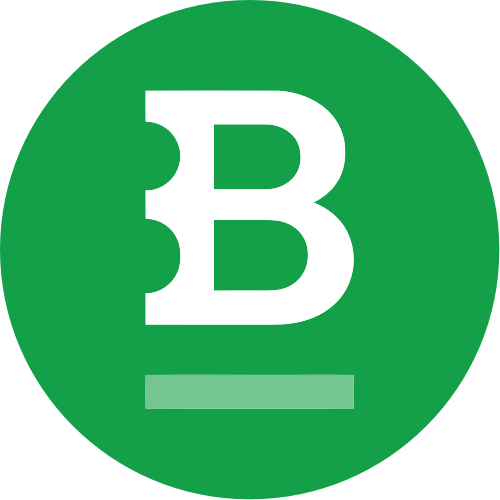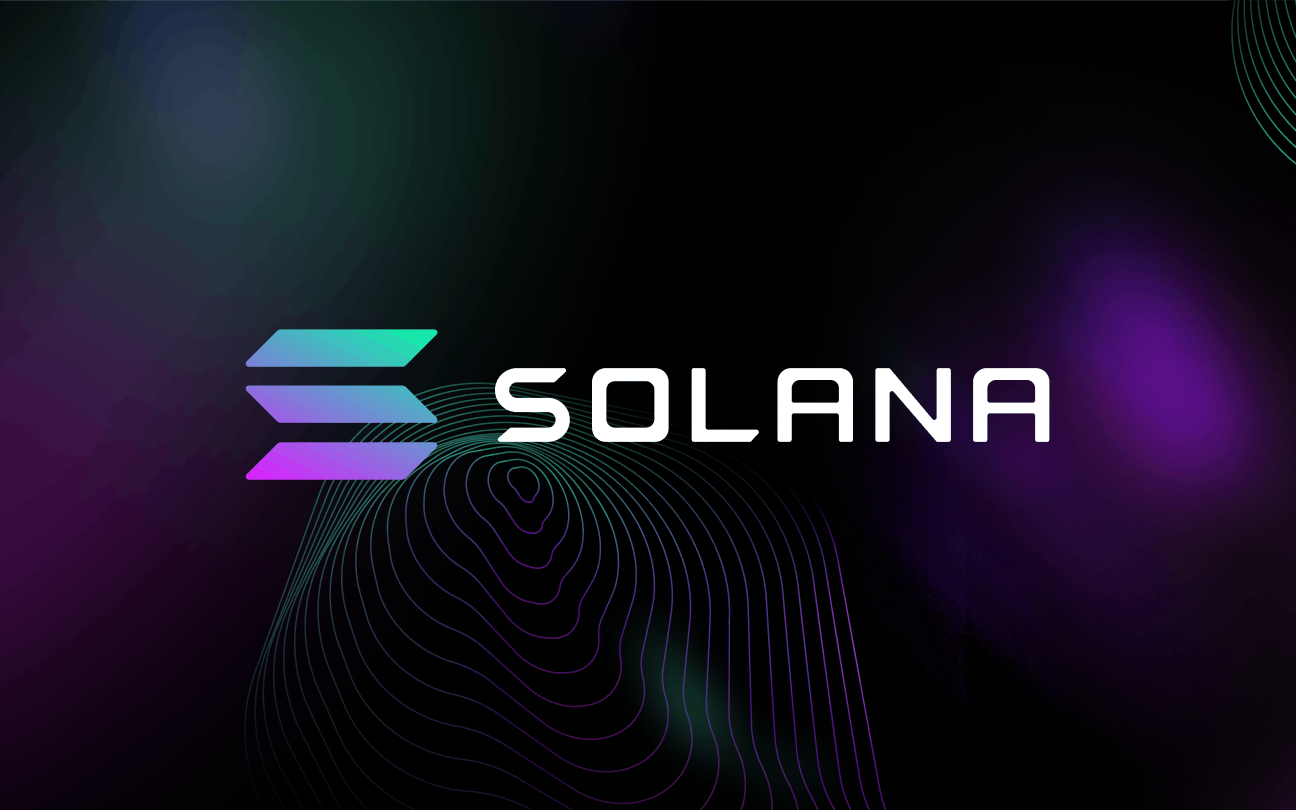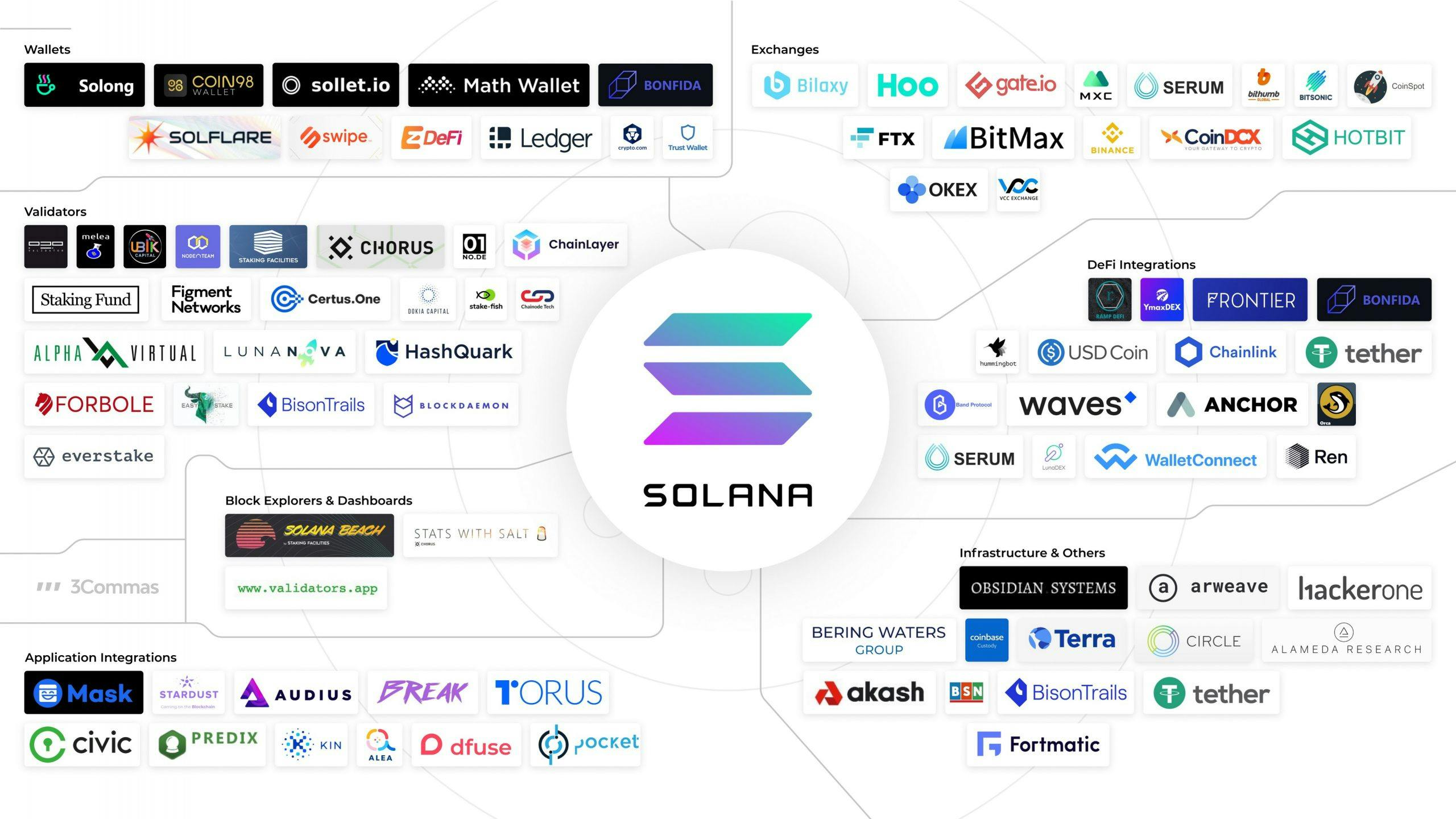
Solana (SOL) Live Price

Market capitalization of a coin is calculated by multiplying the current price in USD or EUR of a single unit of coin by the current circulating supply of that coin available for sale or purchase on public exchanges.
Ex: If the price of BTC is currently $20,000 and there are 50,000 BTC available on public exchanges, then the Market Cap of BTC is $1,000,000,000.
Volume of a coin is the total spot trading volume reported by all exchanges over the past 24 hours multiplied by the value of an individual unit of that coin.
Circulating supply is the approximate number of units of a coin that are currently circulating in the market in the hands of the general public.
Release date is when the first tokens of this cryptocurrency were created and made available for mining or whatever other creation mechanism was specified in this token’s blockchain protocol.
Data provided by Coingecko API
SOL price Statistics
Solana Price Today
Price Change
The percent change in price for this asset compared to 24 hours ago
Trading Volume
Popularity is based on the relative market cap of assets.
Solana Supply
Circulating supply shows the number of coins or tokens that have been issued so far.
Solana Market Cap
Market cap is calculated by multiplying the asset's circulating supply with its current price.
Fully Diluted
Market Cap
Solana Price Yesterday
Solana Price History
The highest price paid for this asset since it was launched or listed.
Data provided by Coingecko API
SOL to USD converter



Data provided by Coingecko API
Real-Time Solana Price Chart (SOL to USD)
Solana Exchanges
Exchange | Price | Pair | Spread | 24 Volume | Last Traded |
|---|---|---|---|---|---|
 Binance | $124.44 | SOL/USDT | $0.01 | $593,206,040 | Recently |
 KuCoin | $124.43 | SOL/USDT | $0.01 | $119,669,530 | Recently |
 Gate | $124.43 | SOL/USDT | $0.01 | $114,426,480 | Recently |
 Coinbase Pro (GDAX) | $142.41 | SOL/USD | $0.02 | $102,442,700 | Recently |
 Kraken | $124.37 | SOL/USD | $0.04 | $50,873,589 | Recently |
 HTX | $124.36 | SOL/USDT | $0.0555 | $33,458,731 | Recently |
 Kraken | $124.65 | SOL/USDT | $0.16 | $4,384,577 | Recently |
 Coinbase Pro (GDAX) | $141.96 | SOL/USDT | $0.08 | $2,198,546 | Recently |
 Binance US | $124.65 | SOL/USD | $0.13 | $1,101,247 | Recently |
 Binance US | $124.53 | SOL/USDT | $0.21 | $693,692 | Recently |
 Bybit | $124.34 | SOL/USD | $0.03 | $184,788 | Recently |
 Bitfinex | $124.76 | SOL/USD | $0.06 | $26,985 | Recently |
 Bitfinex | $124.53 | SOL/USDT | $0.04 | $6,133 | Recently |
 Bitstamp | $124.48 | SOL/USD | $0.001 | $0 | Recently |
Solana Historical Price Data (USD)
Date | ||||
|---|---|---|---|---|
11/30/2025 | $136.088751 | $0 | $139.651924 | $135.865478 |
11/29/2025 | $137.400593 | $136.088751 | $137.671915 | $135.724708 |
11/28/2025 | $140.846451 | $137.400593 | $142.515129 | $137.054631 |
11/27/2025 | $142.922523 | $140.846451 | $143.737549 | $140.751904 |
11/26/2025 | $139.006209 | $142.922523 | $144.368252 | $135.762006 |
11/25/2025 | $138.367713 | $139.006209 | $138.771397 | $134.140232 |
11/24/2025 | $130.848975 | $138.367713 | $138.990304 | $128.989631 |
Data provided by Coingecko API
SOL Price Live Data
The live price of SOL is $ 125.9 per (SOL/USD) today with a current market cap of 70.49B USD. 24-hour trading volume is $ 5,722,940,800 USD. SOL to USD price is updated in real-time. Solana is -8.70% in the last 24 hours. It has a circulating supply of $ 559,653,000 SOL.
Solana Coin Price Chart determines the exchange rates between major fiat currencies and cryptocurrencies – including BTC, ETH and XRP to USD, EUR, GBP. Conversion rates are based on Live SOL Price Index and the price indices of other digital assets.
This content and any information contained therein is being provided to you for informational purposes only, does not constitute a recommendation by Coinbase to buy, sell, or hold any security, financial product, or instrument referenced in the content, and does not constitute investment advice, financial advice, trading advice, or any other sort of advice.
What Is Solana (SOL)?
Solana is a functional open-source project that facilitates fast transactions and provides a platform for running decentralized apps. The network started as a white paper – Solana Labs – in 2017 and launched its network three years later. Today, Solana is the 9th-ranked cryptocurrency by market cap.
Solana combines the well-known Proof of Stake with Proof of History to facilitate a fast Defi ecosystem without sacrificing scalability. It also allows developers to create and execute smart contracts on its network.
A Brief History About Solana
Network Engineer Anatoly Yakovenko conceived the idea of Solana. He started as an engineer at Qualcomm, where he served as a senior engineer. In 2015, he was a software engineer at Dropbox.
He started working on Solana in 2017. He particularly published a whitepaper in November of the same year. The whitepaper explained how Bitcoin and Ethereum need ample time to reach a consensus on transactions. The time delay slows transactions and cripples network scalability. To that effect, he suggested a timekeeping consensus mechanism called Proof of History.
The PoH is a distributed system that records historical events to denote time passage, automating transaction confirmation and making the network faster. Thus, improving the overall network.
In 2018, Yakovenko linked up with former Qualcomm colleague Greg Fitzgerald to develop a Solana prototype. Later, both teamed up with five other engineers to build and launch the project. In May 2020, Solana went live.
How Do Solana Work
Blockchain systems like Ethereum operate with a central time-stamping method? The timestamp tags a specific transaction occurring at a particular time. To confirm a transaction, Ethereum has to broadcast timestamps amongst its validators, which slows transaction speed.
But Solana employs a different approach. It uses a decentralized clock called PoH. PoH includes Verifiable Delay Functions that allow each validator to generate his time locally. Thus, nodes don't have to wait for timestamps from a central source.
It maintains the regular Proof of Stake for validation, where validators stake their tokens to confirm transactions. The network facilitates both direct and delegated staking. Thus, users can stake their SOL to validate transactions. Or administer it to an active validator.
PoH and PoS combinations make Solana Network far more efficient and suited to blockchain scalability demands. It can process up to 700,000 transactions per second which is a big upgrade on Ethereum's 15 per second.
Solana also provides a platform for building applications with the help of Blockchains. These apps are similar to regular apps – Facebook and Dropbox. However, they are built on a decentralized ecosystem, thus granting more user power.
What Makes Solana Unique
By combining with PoS, Solana uses Proof of Stake to solve the existing slow validation processing. Thus, improving the overall network efficiency. Solana’s lightning-fast transactions gave it the title 'Visa of Crypto.'
The high transaction speed means the network is also ripe for individual and enterprise usage. Companies that need to process large data can confirm their transactions in seconds. Even with these, Solana charges lower transaction fees compared to Ethereum.
Solana's utility is evident with the network launch of successful smart contracts. Solana's price skyrocketed with emerging crypto applications on the network. For instance, the Degenerate Ape NFT collection was launched and minted in mid-2021. By September 9, 2021, SOL was at an all-time high of $216.
Since then, more institutions have flooded the network — mainly gaming, Defi, and NFTs platforms. Today, Solana Blockchain has over 350 listed projects, with 11 being Defi platforms. It's also supported by an experienced core of Anatoly Yakovenko and Greg Fitzgerald.
Fairly, many have touted Solana as the main blockchain rival to Ethereum and break the latter's smart contracts monopoly. But multiple outages from DDOS attacks have crippled more development of the cryptocurrency. Plus, critics faulted the network for favoring capital investors with unfair tokenomics.
Moreso, Ethereum has solved its scalability issues with a recent suite of clever technologies. It includes Layer 2 projects on Ethereum. And the recent launch of ETH 2.0, which processes 20,000+ transactions. With ETH more suited to scalability, Solana's competitive advantage is eliminated.
SOL Token And Tokenomics
Solana's native cryptocurrency is SOL. SOL provides crypto solutions, including
Solana is an inflationary cryptocurrency with no hard cap. New SOL coins are issued to PoS validators for confirming transactions. Thus, increasing the number of SOLs in circulation over time. Solana started at an annual inflation rate of 8%, designed to decrease by 15% yearly. The inflation rate becomes fixed once it reaches 1.5%.
All the inflationary rewards are shared among the delegated stake accounts and validators.
Solana started an initial seed sale in 2018, where investors got SOL tokens for their investment. The investment included five different funding rounds. In 2020, Solana raised another money through a strategic sale and a Coin list-hosted public auction.
The Initial token distribution of SOL was as follows.
SOL, after launch in March 2020, SOL price started at around $0.5. It never reached the $5 mark for the rest of 2020, with its highest price being $4+ in August 2020.
The 2021 crypto bull run, NFT hype, and increasing fame of Defi gave Solana wide traction. It quickly became one of the most valuable assets to investors. In May 2021, It traded around $55, dipping for some time before going on another price rally.
An SOL token was $216 in September 2021. It cost an all-time high price of $258.93 in November.
Crypto fear & Greed Index

Historical Values
Next Update
The next update will happen in:
7 hours, 53 minutes and 0 seconds
Explore Our Other Products for SOL
DCA Bot
Invest in SOL gradually and reduce risk using our supercharged Dollar-Cost Averaging Bot. Automate your entries at better prices, set take profit targets, and protect your capital with trailing stop loss. No coding required.
Signal Bot
Execute your SOL trading strategy using webhook signals from any source or using a TradingView Strategy.
GRID Bot
Capitalize on SOL price movements 24/7, even in sideways markets. The Grid Bot places smart buy and sell orders within preset ranges to capture every market swing.
FAQ
Actual price of Solana to USD now is $ 125.9
Solana ticker is SOL
You can buy Solana on any exchange or via p2p transfer. And the best way to trade Solana is through a 3commas bot.
You should not expect to get rich with Solana or any other new technology. It is always important to be on your guard when something sounds too good to be true or goes against basic economic principles.
Solana (SOL) hit another all-time high over $ 293.31 in 19.01.2025.
Solana Market Cap is at a current level of 70.49B, down from 76.68B yesterday. This is a change of -8.79% from yesterday.
Latest 24-hour trading of Solana (SOL) is $ 5,722,940,800.
The current circulating supply of Solana is $ 559,653,000 with the maximum amount of $ 0.
Solana current Market rank is #7. Popularity is currently based on relative market cap.











